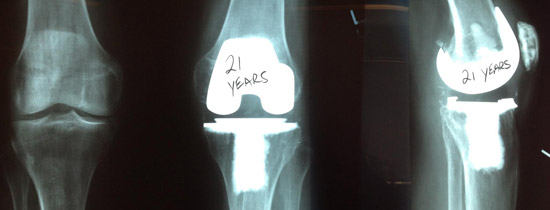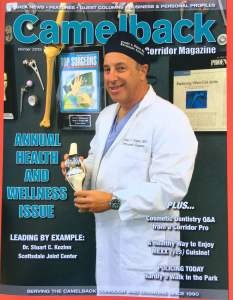TOTAL KNEE RECOVERY:
Total knee recovery is very much related to the control of your pain. I use a muscle sparing approach to knee replacement that minimizes cutting of the quadriceps tendon, allowing for a faster total knee recovery. Depending on the size of the patient’s thigh, more or less “release” is required to move the patella (kneecap) out of the way, so that the metal implants can be inserted. I don’t think the term “minimally invasive” is an accurate way to describe total knee replacement surgery. There is nothing minimal about removing bone from the surface of the femur and the top surface of the tibia. The length of the skin incision, while a definite cosmetic concern, is not really relevant from a functional recovery standpoint. Paradoxically, a longer skin incision most often allows us to move the muscles over without cutting them, much like “spreading curtains”, to gain access to the bone ends.
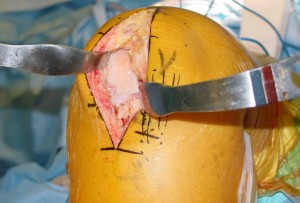
We can do our partial knee replacements with smaller incisions without cutinng the quadriceps muscle, which leads to a faster recovery.
(BTW: Our muscle sparing anterior hip replacement operations are similar, in that we can implant the prosthesis without cutting any muscles at all, as long as we can spread the longitudinal muscles apart -the interval between rectus femoris and tensor fascia latta). So how do we control pain? I am glad you asked!
Our pain management protocol is multimodal, meaning we use different modalities working on different pain pathways to add up to excellent pain relief without side effects. In the “old way”, a patient may have received a general anesthetic and IV narcotic therapy. This leads to a sudden surge of severe pain when the anesthesia is terminated. Narcotics have various negative side effects: Lethargy, respiratory depression, nausea, vomiting, sick feeling, confusion, anxiety, itching and constipation to name a few. Instead, we use a regional anesthetic ( spinal or epidural) which completely removes all pain until it gradually wears off. The gradual wearing off is a key component, in that our human brains better accommodate to pain in a gradual way, allowing us to respond by secreting our own endogenous “narcotic like” substances called endorphins and encephalin. During this time, and additional modality, a femoral nerve block, continues the pain blockade to about 70% of the knee (much like the dentist blocks the nerves in your gums with a “novacaine”shot.) The femoral nerve block, or a newer version called the “adductor canal block” is applied in the pre-op area by the anesthesiologist before the spinal is put in. The patient can still have as much IV sedation as is required to alleve anxiety. Some patients prefer to stay “awake” throughout the procedure, and often I have had conversations with patients during their painless surgeries! This technique is especially good in an elderly patient who is prone to confusion after receiving narcotics of sedatives.
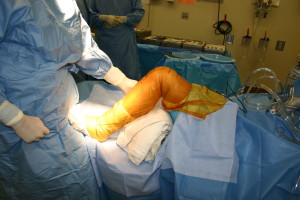
the knee is encased in antibiotic impregnated steriele plastic to protect against skin bacteria entering the wound.
We also inject a potent local anesthestic called “Exparel”, which is a long acting “novacaine” type drug, in the skin and subcutaneous tissues to prolong the pain relief. This can have an effect up to 72 hours! As the spinal wears off in the recovery room, the patients are usually quite comfortable when I visit them before going up to their room. I often hear that “I have no pain:, but every patient going through total knee recovery is different. There is no question that we are all “wired” differently in regard to our tolerance and perception of pain. We also give medications, but slowly and gradually. We often add a “Celebrex” pill pre-op with a sip of water. We use IV “Tylenol” ( acetamenophin) pre-op as well. these medications are working in the background adding tot he multi-modality pain control.
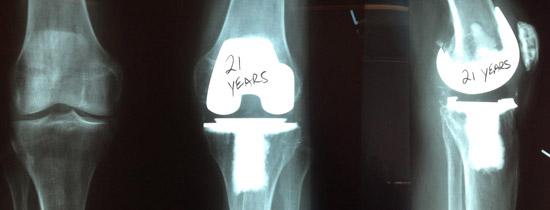
Dr. Kozinn has been doing total knees for 28 years. here is one that followed up after 21 years and is doing great!
Our workhorse “drug” is IV Toradol, which is an aspirin like anti-inflammatory with super pain control ability. As long as there are no medical contraindications to its use (prior GI bleeding or Kidney failure), it is extraordinarly effective at controlling pain. With all of these techniques together, total knee recovery can be much more rapid. Early ambulation and mobility adds to the dynamics of pain control. When patients get out of bed early, they use positive mindset to decrease the perception of pain. We no longer use CPM machines as they keep patients strapped in bed. Range of motion is better when patients get up and walk an hour or two right after the surgery.
If you think you could benefit from a knee replacement, please come in to our office and have an evaluation. Total knee recovery is not as bad as it use to be.
Stuart C. Kozinn MD.




